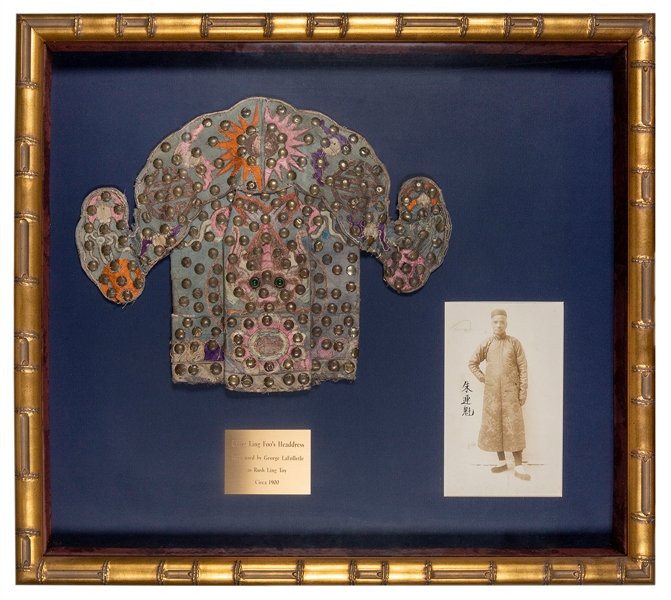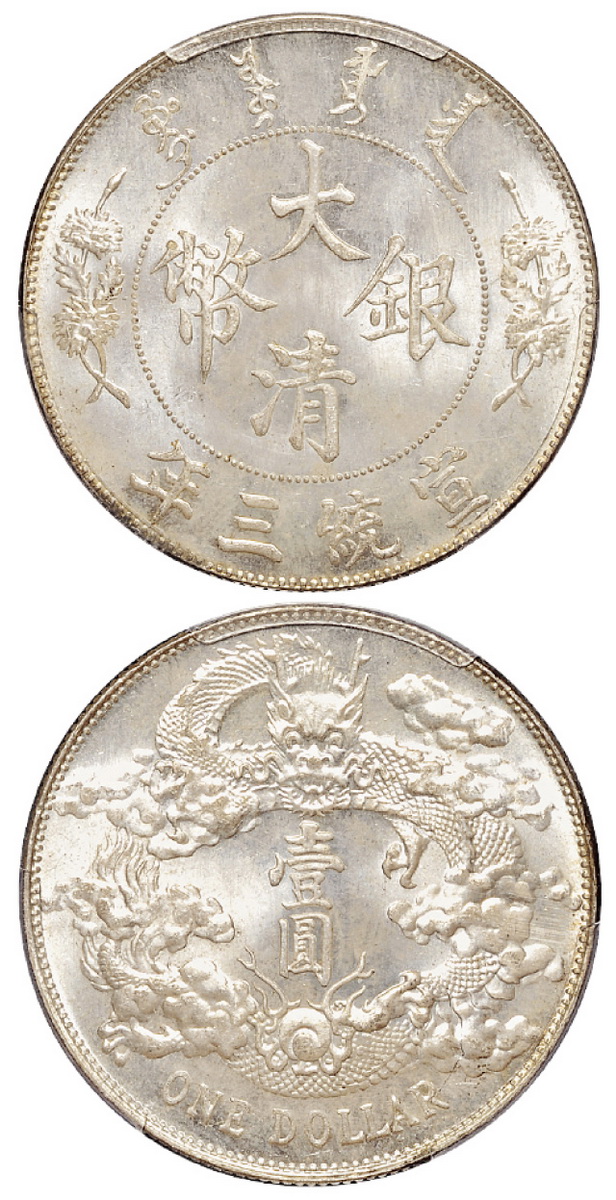MOHL, JULIUS, editor. Y-King: Antiquissimus Sinarum Liber Quem Ex Latina.... Stuttgart and Tubingen: J.G. Cotta, 1834-1839. 2 volumes. 12mo (204 x 126 mm). 4 folding plates. Contemporary wrappers, with the contemporary bookseller's label of Friedrich Klincksieck, affixed inside cover of volume 2, uncut, volume 2 unopened. THE FIRST TYPOGRAPHICAL PRINTING OF THE I-CHING IN ANY LANGUAGE — A PRISTINE, UNCUT COPY. THE ORIGIN TEXT OF CHINESE CIVILIZATION, the I Ching was revealed to the emperor Fu Hsi 5000 years ago. Based in the patterns and processes of nature ("Tao"), the I Ching teaches the science of Change and movement in accord with nature. In pre-modern times its symbolism and numerology were applied to the explanation of a wide range of sciences—from physics and astronomy to biology, chemistry, and geology—and devotees of the book are today seeking to apply its text to the study of computing and DNA sequencing. The I Ching is of course famous as a text of divination. Indeed it is the most famous work of such kind—translated into almost every language on Earth and one of the bestselling books of all time. The I Ching is the first and foremost Chinese classic – a cornerstone of both Taoism and Confucianism. The full text was developed over the course of three millennia: Fu Hsi discovering the original 8 trigrams c. 3000 BCE; King Wen (founder of the Zhou dynasty) inventing the 64 hexagrams c. 1000 BCE; and "Ten Wings" or commentaries being added to the text c. 300 BCE. The book received imperial sanction as one of the five major Confucian classics in 136 BCE and maintained its official status until the end of the Chinese empire in 1912. The I Ching's great prestige in China caused the text to be embraced by other Asian cultures (most notably Korea, Japan, and Vietnam), and with succeeding centuries the text's fame and influence has only grown. Beginning with the 17th century Enlightenment, the I Ching was studied by multiple western thinkers and artists from Leibniz to Carl Jung and John Cage INSPIRATION FOR LEIBNIZ'S INFLUENTIAL WORK WITH BINARY NUMBERS. The "father of the computer" and the first high-level European Sinophile, the famed mathematician Leibniz explicitly discussed the I Ching in his ground-breaking 1703 article on binary arithmetic, later translated into English as "An Explanation of Binary Arithmetic Using Only the Characters 0 & 1, with Remarks about its Utility and the Meaning it Gives to the Ancient Chinese Figures of Fohy [Fu Hsi]." Leibniz's original article was the first printed work on the idea and use of binary number—integrally linking the I Ching with the foundation of computing. Leibniz appears to have nursed the idea of binary number for some decades before his 1703 article, but it seems that his thoughts came to fruition and print as the result of a 1697-1703 correspondence about the I Ching with the Jesuit Joachim Bouvet. In 1697 Bouvet received a copy of Leibniz's Novissima Sinica, a collection of Jesuit letters and essays relating to China which Leibniz had edited, and Bouvet took it upon himself to begin a correspondence. In February, 1701, Leibniz wrote Bouvet a letter describing the principles of his binary arithmetic, including a table of binary representations through the number 32. Bouvet immediately recognized the similarity of Leibniz's binary logic to the structure of the I Ching's hexagrams. He excitedly returned a letter to Leibniz, sending a woodcut of Shao Yong's "Former Heaven Chart" and pointing out to Leibniz the inherent binary logic and comparing it directly to Leibniz's own system. It took 17 months for Bouvet's letter to reach Leibniz; but when it finally did come, Shao Yong's chart hit Leibniz like a lightning bolt—prompting him to immediately submit his article on binary arithmetic and to explicitly discuss the I Ching in its text. Our modern digital age is a direct outgrowth of the ideas advanced in Leibniz's landmark article. The present work is based in the earlier u
MOHL, JULIUS, editor. Y-King: Antiquissimus Sinarum Liber Quem Ex Latina.... Stuttgart and Tubingen: J.G. Cotta, 1834-1839. 2 volumes. 12mo (204 x 126 mm). 4 folding plates. Contemporary wrappers, with the contemporary bookseller's label of Friedrich Klincksieck, affixed inside cover of volume 2, uncut, volume 2 unopened. THE FIRST TYPOGRAPHICAL PRINTING OF THE I-CHING IN ANY LANGUAGE — A PRISTINE, UNCUT COPY. THE ORIGIN TEXT OF CHINESE CIVILIZATION, the I Ching was revealed to the emperor Fu Hsi 5000 years ago. Based in the patterns and processes of nature ("Tao"), the I Ching teaches the science of Change and movement in accord with nature. In pre-modern times its symbolism and numerology were applied to the explanation of a wide range of sciences—from physics and astronomy to biology, chemistry, and geology—and devotees of the book are today seeking to apply its text to the study of computing and DNA sequencing. The I Ching is of course famous as a text of divination. Indeed it is the most famous work of such kind—translated into almost every language on Earth and one of the bestselling books of all time. The I Ching is the first and foremost Chinese classic – a cornerstone of both Taoism and Confucianism. The full text was developed over the course of three millennia: Fu Hsi discovering the original 8 trigrams c. 3000 BCE; King Wen (founder of the Zhou dynasty) inventing the 64 hexagrams c. 1000 BCE; and "Ten Wings" or commentaries being added to the text c. 300 BCE. The book received imperial sanction as one of the five major Confucian classics in 136 BCE and maintained its official status until the end of the Chinese empire in 1912. The I Ching's great prestige in China caused the text to be embraced by other Asian cultures (most notably Korea, Japan, and Vietnam), and with succeeding centuries the text's fame and influence has only grown. Beginning with the 17th century Enlightenment, the I Ching was studied by multiple western thinkers and artists from Leibniz to Carl Jung and John Cage INSPIRATION FOR LEIBNIZ'S INFLUENTIAL WORK WITH BINARY NUMBERS. The "father of the computer" and the first high-level European Sinophile, the famed mathematician Leibniz explicitly discussed the I Ching in his ground-breaking 1703 article on binary arithmetic, later translated into English as "An Explanation of Binary Arithmetic Using Only the Characters 0 & 1, with Remarks about its Utility and the Meaning it Gives to the Ancient Chinese Figures of Fohy [Fu Hsi]." Leibniz's original article was the first printed work on the idea and use of binary number—integrally linking the I Ching with the foundation of computing. Leibniz appears to have nursed the idea of binary number for some decades before his 1703 article, but it seems that his thoughts came to fruition and print as the result of a 1697-1703 correspondence about the I Ching with the Jesuit Joachim Bouvet. In 1697 Bouvet received a copy of Leibniz's Novissima Sinica, a collection of Jesuit letters and essays relating to China which Leibniz had edited, and Bouvet took it upon himself to begin a correspondence. In February, 1701, Leibniz wrote Bouvet a letter describing the principles of his binary arithmetic, including a table of binary representations through the number 32. Bouvet immediately recognized the similarity of Leibniz's binary logic to the structure of the I Ching's hexagrams. He excitedly returned a letter to Leibniz, sending a woodcut of Shao Yong's "Former Heaven Chart" and pointing out to Leibniz the inherent binary logic and comparing it directly to Leibniz's own system. It took 17 months for Bouvet's letter to reach Leibniz; but when it finally did come, Shao Yong's chart hit Leibniz like a lightning bolt—prompting him to immediately submit his article on binary arithmetic and to explicitly discuss the I Ching in its text. Our modern digital age is a direct outgrowth of the ideas advanced in Leibniz's landmark article. The present work is based in the earlier u















Try LotSearch and its premium features for 7 days - without any costs!
Be notified automatically about new items in upcoming auctions.
Create an alert